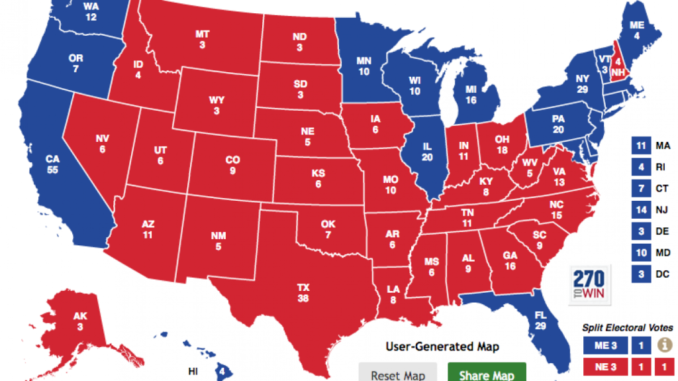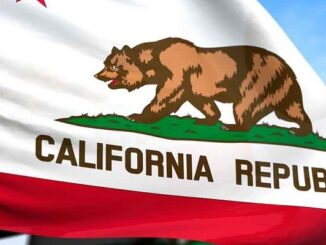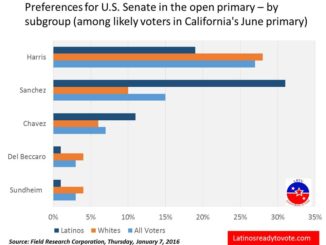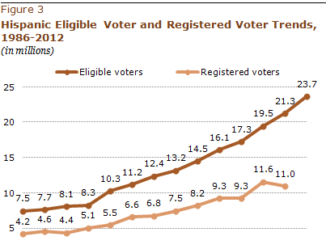
, Washington Post
What that means in practical terms is that if Clinton wins the 19 states that every Democratic nominee dating to her husband has won and she wins Florida (29 electoral votes), she wins the White House. It’s that simple.
Or if she wins the 19 reliable Democratic states and Virginia (13 electoral votes) and Ohio (18). Or the 19 states plus Nevada (6), Colorado (9) and North Carolina (15).
You get the idea. There are lots and lots and lots of ways for Clinton — or any Democratic nominee — to get to 270 electoral votes. There are very few ways for Trump — or any Republican nominee — to get there.
It’s easy — and, for many Republicans, useful — to cast this electoral-college morass as Trump’s fault, the obvious outcome of nominating a candidate who has historically high unfavorability numbers among key groups.
But to do so ignores recent history. Barack Obama won 365 electoral votes in 2008 and 332 in 2012. The Republican presidential nominee hasn’t crested 300 electoral votes since the 1988 election, when George H.W. Bush won 426. (George W. Bush won the White House with 271 electoral votes in 2000 and claimed a second term with 286.)
Democrats’ electoral-map advantage echoes the clear headstart Republicans had during the 1980s, when Bush’s 426 electoral votes were the fewest that the GOP presidential nominee won that decade. Ronald Reagan won the White House in 1980 with 489 electoral votes and followed that up with 525 in 1984.
The current Republican disadvantage in the electoral map is less about any individual candidate than it is about demographics. As the country, and the voting public, has become less white and as Republicans have proved incapable of winning over nonwhite voters, a number of states have moved toward Democrats over the past decade.
Perhaps the best example of this movement and how it has hurt Republicans is New Mexico, whose population is almost half Hispanic. In 2004, George W. Bush won the Land of Enchantment in his bid for a second term. (His margin over John F. Kerry was 588 votes.) Eight years later, Obama won the state by 10 percentage points over Mitt Romney; neither side targeted it in any meaningful way. In 2016, it’s not even on the long list of potentially competitive states.
[The Republican problem with Hispanic voters — in 7 charts]
What has become increasingly clear is that any state with a large or growing nonwhite population has become more difficult for Republicans to win. Virginia and North Carolina, long Republican strongholds, have moved closer and closer to Democrats of late. (Obama won both states in 2008 and carried Virginia in 2012.)
At the same time, as these states have grown friendlier to Democrats, there are very few states that are growing increasingly Republican. Wisconsin and Minnesota are two, but neither is moving rapidly in Republicans’ favor just yet.
Trump isn’t to blame for any of that. But his remarkably high disapproval numbers among Hispanics and his hard-line stance on illegal immigration — we are going to build a wall and make Mexico pay for it! — could make what is already a huge demographic or electoral-map problem for Republicans even worse.
A poll released Sunday in Georgia shows Trump at 42 percent to Clinton’s 41 percent. Arizona, long a Republican stronghold at the presidential level, could be in play this year because of Trump’s terrible numbers among Hispanics.
The counter-argument made by Trump allies is that he can make the industrial Midwest more competitive than past Republican nominees because of his strengths among white male voters.
Wins in Wisconsin, Michigan or Pennsylvania would certainly open up the map for Republicans in ways that recent nominees have been unable to do. But, so far at least, there’s scant polling evidence that Trump can put those states in play in the fall.
Trump doesn’t help matters. But the Republican map problem goes deeper than him — or any one candidate. Blaming Trump for a loss in November would not only miss the point but may ensure that Republicans are doomed to repeat history in 2020.



